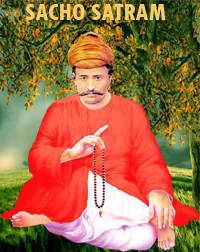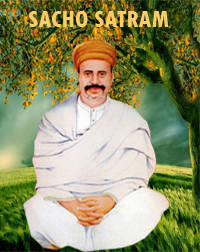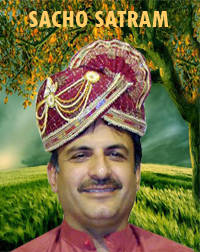During an interview, Sai Sadhram Saheb revealed that he was born in Raharki Sahib, Sindh, on October 25, 1963. He described Raharki Sahib as a land marked by unconditional and divine love, bestowed by Shahanshah Satguru Sant Sai Satramdas Sahib.
He pursued his second-grade education in Jarwahran Sahib as his maternal family relocated from Khushkan to Jarwahran Sahib. However, for the third grade, he attended school in Raharki Sahib. Moving forward, he completed the fourth grade in a nearby village, and his fifth-grade education took place in Bhuto Ka Village. He mentioned having completed his primary education in various locations. Following that, he successfully passed his tenth-grade exams and went on to complete his first and second-year junior college in Shikarpur.
He completed B. Com from Sukkhur, law from Khairpur and MA from Shikarpur.
Saijan mentioned that he simultaneously managed his own business while also holding a job..
In 1990, Dulha Darvesh Sai Kanhaiyal Lal Saheb directed him to assume the role of the successor to Shahanshah Satguru Sant Sai Satram Das Saheb and shoulder the complete responsibility of Sant Satram Dham Raharki Saheb.
Saijan mentioned that from the outset, his family had a connection with the Sants of Raharki Saheb. Sindh is a region renowned for its great Sants, Mahapurshs, sufis, darveshs, and spiritual heritage.
The profound connection of great Sants, Fakirs, and Darvesh extends to every particle, place, city, and village in Sindh.
Sindh stands as the singular, blessed, and sacred land where humanity has received genuine knowledge and wisdom.
Throughout history, Sindhis have consistently contributed significant cultural values while also embracing cultural elements from various cultures and religions worldwide. This openness stems from the Sindhi tradition of appreciating and respecting diverse religions and their rich cultures.
The Hindu roots trace back to the era of the Vedas.
The Vedas were composed on the shores of the Sindhu River.
Subsequently, Buddhism emerged, and its cultural values found acceptance among Sindhis, leading to the construction of numerous Buddhist Stupas in Sindh. Following that, Islam was introduced, and its cultural values were respected by the people of Sindh. The first translation of the Quran was undertaken in Sindhi. Additionally, the initial translation of Guru Granth Sahib was also carried out in Sindhi. Later, the translation of Granth Sahib was accomplished by the Maharaja of Patiala.
Sindhis have embraced the beauty from various parts of the world.
Hence, the Sindhi culture stands as one of the most enriched cultures globally, given its seamless acceptance, appreciation, and integration of the profound values and practices from diverse cultures. Throughout its millennia-long history, Sindh has never initiated aggression against any other state or community. Instead, Sindh has consistently welcomed others with affection. Unfortunately, Sindh has endured numerous attacks from various rulers who have governed the region for extended periods, subjecting its people to brutal oppression.
Sindhis, despite facing cruel treatment from traitors or outsiders, chose to coexist peacefully with them. These outsiders, influenced by the prevailing spirit of love, eventually assimilated into Sindhi culture. The inherent compassion and spiritual ethos in Sindh have resulted in individuals from various backgrounds, such as Tarkhan, Pathan, Syed, and others, adopting the Sindhi identity. People from diverse castes and religions have transformed into Sindhis in Sindh, fostering harmonious coexistence among them.
Hindus, Muslims, Marwadi, Kathhyawadi, and individuals from various castes and religions residing in Sindh identify as Sindhis, fostering a harmonious coexistence. Sindhis seamlessly integrate with diverse communities, readily accepting outsiders and blending their positive cultural values with their own customs. The Sindhi community has embraced and incorporated a wide array of religions, castes, customs, rituals, literature, and more into their culture. This inclusivity stems from the Sindhi belief in unity, a singular God, and the essence of humanity. Sindh can be aptly described as a land characterised by Sufism, Sants, Darveshs, Mahatmas, and fakirs.
In Sindh, animosity is foreign, and the land itself is characterised by love and brotherhood. The inhabitants of Sindh are affectionate individuals who do not harbor enmity but instead cultivate beautiful and loving relationships with others.
Sindh has been home to illustrious Sants, Mahatmas, and Darveshs. Figures such as Sant Satramdas Saheb, Sant Kanwarram Saheb, Shah Abdul Latif Bhitai, and Sachal Sarmast were not only individually remarkable but also shared deep connections with each other and the magnificent land of Sindh..
The esteemed figures of Shah Abdul Latif Bhitai and Sant Kanwarram are held in high regard and cherished by people from diverse communities and religions residing in Sindh. Hazir Swaroop Sai Sadhram Saheb emphasized his association with a place of worship where both Hindus and Muslims equally honor the great poet Shah Bhitai and Sant Kanwarram Sahib.
In Raharki Sahib, there is no distinction made between communities, and those who come seeking blessings are accepted, blessed, and treated equally. He expressed that his connection to the sacred Dham of Sant Satram Dham is both cultural and rooted in his lineage..
Saijan mentioned that his grandfather, hailing from Jarwar, Sindh, was a landowner with approximately 22 thousand Jareb, equivalent to 11 thousand acres of land. Within his taluka, he held the second position among other landowners.
Saijan revealed that two daughters of Sant Sai Satramdas Saheb, one of whom was his grandmother, were married into the same family. Since none of Shahanshah Satguru Sant Sai Satram Das Saheb’s three sons lived to adulthood, Sant Sai Kanwaram Saheb took over the responsibilities at Raharki Saheb after him. After Sant Sai Kanwaram Saheb’s passing, Saijan’s grandfather, a Landlord, assumed the responsibilities at Raharki Saheb. Consequently, Saijan explained that he is doubly connected to Raharki Saheb – one link through his family’s landlord lineage and the other as a seeker of the Lord.
As a result, Hazir Swaroop Sai Sadhram Saheb mentioned that he incorporates both spiritual and worldly practices into his approach and conduct.
In Sindhi tradition, it is often mentioned by our elders that God crafted Sindh 40 years before shaping the rest of the world. Similar to the construction of a building, where a model is created beforehand, Sindh was envisioned as a prototype by the Lord before the formation of the entire world.
Various countries and regions across the world exhibit distinct characteristics. Upon observation, it becomes apparent that some areas are mountainous, others have coastlines, some are lush with greenery, some are deserts, certain regions are abundant with rivers, and the water in different areas varies from sweet to sour.
However, upon examining the geographical features of Sindh, we can discern that the region encompasses a diverse landscape. Sindh boasts mountains, an ocean, rivers, both sour and sweet water sources, green hills, as well as arid hills, deserts, and moist lands. Karachi, is situated on Arabian Sea. Sant Satram Dham is situated where there is greenery everywhere. Dadu has broken hills, while Gorakh is adorned with green hills. Additionally, Sindh features the Thar Desert and the Sindhu River. Consequently, within Sindh alone, one can find regions representing a wide array of landscapes.
In contrast, when we explore other countries, we discover landscapes that are mountainous, desolate deserts, riverine territories, and coastal areas. However, Sindh encompasses every conceivable type of region. Whatever exists globally is also present in Sindh. If something is absent in Sindh, it can be deemed nonexistent in the entire world. Hence, Sindh can be regarded as a microcosm representing the diverse landscapes found throughout the world.
Hazir Swaroop Sai Sadhram Saheb emphasised that the geographical makeup of a region significantly influences the characteristics and personalities of its inhabitants. Individuals from distinct regions often exhibit diverse personalities.
Every 10 to 12 kilometers, the way people pronounce words undergoes a change. In Sindh, the locals can discern the region a person hails from simply by listening to their pronunciation. By paying attention to someone’s speech, it becomes apparent whether they are from Rohri, Sukkur, Ghotki, Shikarpur, Dadu, Larkana, Mirpurkhas, or Karachi.
In various regions of Sindh, the traditions, rituals, and ways of life exhibit notable differences.
Sindh encompasses a diversity of people, climates, pronunciations, and resources. This adaptability enables Sindhis to thrive in various regions worldwide, as they possess the capability to adjust to changes in their environment..
This is the reason why Sindhis thrive and prosper wherever they reside; they are known for their generosity and thoughtfulness.
Wherever Sindhis choose to settle, they assimilate the local culture, as their origins trace back to Sindh—a region characterised by a diverse range of variations
Saijan mentioned that dismantling any community is a challenging task, as it requires first undermining its language. Given that Sindh spans various regions and climates, Sindhis can easily adapt to different environments worldwide, and their language remains robust due to their deep-rooted connections. It is often asserted that Sindhi is akin to Sanskrit, highlighting its strength and historical significance.
Sindhi stands as one of the most affluent languages globally, boasting 52 letters. The richness of Sindhi is evident in its pronunciation, where our tongue navigates throughout the mouth, engaging with every part. This distinctive quality allows a Sindhi speaker to articulate any language worldwide with remarkable fluency. Much like the Earth’s round shape, a Sindhi speaker’s tongue exhibits a circular movement, underscoring that Sindhi language is indeed a source of strength.
The ability to speak Sindhi fluently empowers us to articulate any language worldwide with ease. If we neglect teaching Sindhi to our children, their proficiency in mastering other languages might diminish. Hence, it is imperative that we prioritise the teaching of Sindhi to our younger generation..
Sindhi is a language of wealth. Sindhis thrive wherever they go, as their language and the land they originate from have a profound influence.
For nearly 70 to 71 years, a significant number of Sindhis have migrated from Sindh and established themselves in various countries. Considering that each generation spans approximately 20 to 25 years, the current period marks the conclusion of the third generation of Sindhis who departed from Sindh about seven decades ago and now reside in other nations.
Typically, within our Dharama, we emphasize the significance of seven generations. The genetic strength of a community endures for seven generations, gradually weakening thereafter. Although the genetic heritage of a community may persist for a maximum of ten generations, beyond that point, the community undergoes a transformative shift.
If a community severs all connections with its original place and roots, it faces the risk of complete extinction.
Observing the perspectives of our elders and our children, we find a significant contrast in their thought processes. Our elders were characterised by thoughtfulness, deep thinking, sensibility, foresight, and vision. In the present times, there is a considerable reliance on digital and pre-made items, with many individuals finding it challenging to perform calculations without the aid of calculators.
Saijan emphasised the necessity for the younger Sindhi generation to establish a connection with their roots by visiting Sindh and the Sant Satram Dham temple. He believed that such visits would serve to refine their thoughts. The unique atmosphere, climate, and overall ambience of the land can influence their minds positively, cultivating qualities like sharpness, thoughtfulness, sensibility, and foresightedness—similar to those exhibited by their elders.
Establishing a connection with our homeland and mother tongue enhances our intelligence and wisdom.
Sindhis are genuinely blessed by their Sants, their land, and their language. Wherever they go, they carry the blessings and prayers with them, and the more prayers and blessings they receive, the greater progress they achieve.
Without receiving blessings and prayers for ourselves and our children, we will lag behind and fail to experience genuine progress.
Our children were unable to grasp their mother tongue due to the prevailing belief that English is superior to other languages. Consequently, languages like Hindi, Urdu, or other regional languages were undermined, considered secondary or tertiary, while English was elevated as a superior, first-class language.
Regrettably, Sindhi was unjustly labelled as a third-class language, as people were misled by the incorrect notion that Sindhi had no practical advantages and was deemed useless.
It was, in fact, a conspiracy by the invaders, as they were aware that if the people of Sindh learned to write and speak Sindhi, they would become sharp, sensible, intelligent, and would make significant progress and success in any profession they pursued.
The external forces present in Sindh aimed to hinder Sindhi progress and sought to curtail their development. Acquiring proficiency in a rich language empowers individuals, but these invaders wished to hinder Sindhis from achieving success. Their agenda was to degrade and dominate them, leading them to propagate negative narratives against Sindhi. These external entities were aware that if people learned Sindhi, they would gain the ability to easily grasp other languages and thrive wherever they ventured.
Speaking Sindhi is just as crucial as writing in Sindhi. It is imperative that we understand how to express ourselves in the written form of Sindhi. This language possesses unique letters, words, and pronunciations that set it apart from others.
Familiarity with Sindhi elevates our standards, given its richness with a diverse array of pronunciations and alphabets. The capability to articulate various pronunciations enables an individual to easily learn and speak any language worldwide. Therefore, it is essential for us to make conscious efforts to appreciate and value this linguistic treasure.
Our wealth is preserved and enhanced only when we take care of and protect our valuable treasure.
Following the Partition, when Sindhis from Sindh relocated to India, they arrived with no financial resources. They had forsaken all their properties and wealth, arriving in India with empty hands. Facing a lack of proper accommodation and basic necessities like food, they had no shelter or support. While they cannot be termed as refugees, as there was no specific refuge for them in India, their arrival marked a challenging chapter in their lives.
Transported in trucks, they were dropped off at unfamiliar locations, leaving Sindhis disoriented about where to go or seek shelter. Once prosperous in Sindh, they arrived in India with their families, having abandoned their wealth and possessions. Faced with the need to survive, they wandered from place to place in pursuit of employment opportunities.
However, their inherent wisdom, intelligence, and the blessings of their Sants and ancestral land were sufficient for them to begin anew from the ground up.
Embarking on new ventures, they initiated small businesses and engaged in various jobs with unwavering dedication, honesty, and hard work. Wherever Sindhis ventured, their enthusiasm, coupled with the blessings of their land, Sants, Mahatmas, as well as their commitment, honesty, and diligence, propelled them to success, thriving in various businesses and professions.
Sai Sadhram Saheb underscored the significance of today’s young Sindhi generation comprehending, appreciating, and respecting their culture and roots. He emphasized the need for Sindhi children to cherish the invaluable blessings bestowed by the great Sants of Sindh and their connection to the land. Saijan highlighted the importance of raising awareness among the younger generation about the richness of their culture, language, and civilization..
Our children need to understand the significance of speaking Sindhi. They should recognise that speaking Sindhi not only enables them to effortlessly learn other languages but also allows them to adapt and thrive anywhere in the world. Failure to connect with our roots may confine us to a limited corner of the world. Saijan emphasised that God has bestowed upon us exceptional qualities, and it is our responsibility to demonstrate and honor these gifts.
As Sindh is the land where all the Vedas and scriptures were written on the banks of the Sindhu River, the people born and raised here are endowed with profound and civilised cultural values. These values accompany them wherever they go.
The inception of Hindu Dharma originated on this land. The birth of great Sants and Mahatmas has enriched this land with a profound culture and abundant blessings. The roots of Hindu Dharma run deep and are boundless.
Hazir Swaroop Sai Sadhram Saheb elucidated the concept of Dharma, clarifying that it is not merely a religion. Instead, Dharma refers to behavior. For example, the Dharma of fire is to burn, the Dharma of a snake is to slither, and the Dharma of a lion is bravery. In essence, Dharma transcends religious boundaries and signifies inherent behavior.
Hindus do not adhere to a religion but to Dharma. They identify as dharmik rather than religious. While religion may have limits and laws, Hindu Dharma is boundless and unrestricted.
Religion entails adherence to a saint, a Mahatma, an institution, a book, or specific customs, rituals, and beliefs. Those who subscribe to any of these elements are obligated to live their lives in accordance with the rules set forth by the respective institutions, saints, or books. Failure to comply may result in rejection or expulsion from that particular religious community.
In Hindu Dharma, individuals who do not follow or believe in specific saints, Mahatmas, Devis, Devtas, or institutions still remain Hindus. Hindu Dharma perceives Parmatma as universal, meaning the divine is the singular force for all species. All saints, Mahatmas, Devis, Devtas, holy books, and institutions within Hindu Dharma are considered part of the universal, omniscient Parmatma, signifying that Parmatma is omnipresent and all-encompassing.
Hindu Dharma is boundless and universal, embracing all, with nothing excluded from its fold. In Hindu Dharma, Parmatma is considered the highest form of everything in the universe. Parmatma is incomparable and holds a supreme position.
The intriguing aspect of Hindu Dharma lies in its inclusivity. Whether someone is an atheist or a believer, whether they have faith in Parmatma or not, they are still considered Hindu. Whether one engages in prayer or not, they remain a Hindu in Hindu Dharma. The title of being a Hindu cannot be taken away from anyone, be they believers or non-believers—everyone falls under the umbrella of Hindu Dharma. Hindu Dharma is not just a religion but a way of life. Within Hindu Dharma, we, as humans, prioritise humanity as our way of life..
Various people from diverse places adhere to different methods, but Hindus embrace and follow a multitude of methods..
Hindus do not distinguish between individuals and consider everyone as an integral part of their community.
Hazir Swaroop Sai Sadhram Saheb enlightened people with the wisdom of being blessed with Navda Bhakti, which comprises devotion in nine different forms. The number nine is infinite and remains constant in the worldly context. A unique characteristic of the number nine is that multiplying any number by 9 and summing the resulting digits will always yield 9..
For example:
9 multiplied by 6 equals 54, and the sum of the resulting digits (5 + 4) equals 9.
9 multiplied by 9 equals 81, and the sum of the resulting digits (8 + 1) equals 9.
9 multiplied by 5 equals 45, and the sum of the resulting digits (4 + 5) equals 9.
However, if we multiply any other number, the sum of the resulting digits will not be the same. For example:
6 multiplied by 8 equals 48, and the sum of the resulting digits (4 + 8) equals 12.
5 multiplied by 5 equals 25, and the sum of the resulting digits (5 + 5) equals 10.
7 multiplied by 7 equals 49, and the sum of the resulting digits (4 + 9) equals 13.
The Rudraksha mala consists of 108 beads, and it is noteworthy that 108 can be evenly divided by the number 9.
The Sanskrit alphabet comprises 54 letters, each having both masculine and feminine aspects, representing Shiva and Shakti. When we sum the digits of 54 (5 + 4), we get 9. Additionally, if we multiply 54 by 2 (representing Shiva and Shakti), we get 108. In the context of the Heart chakra, it is believed that there are 108 energy lines converging to form the chakra, signifying the intersections of energy lines within the spiritual body.
The significance of the number 9 is reflected in various aspects of Hindu beliefs and practices. There are 9 planets, and according to Hindu mythology, Brahma is attributed to creating the universe in 9 days. Navaratri, a Hindu festival celebrating the triumph of good over evil, spans 9 days, with each day dedicated to a distinct form of Maa Durga. The Navagrahas, representing the 9 planets in Hindu astrology, are believed to exert a substantial influence on human life. In a broader sense, the number 9 is thought to symbolize completeness or wholeness.
Geographically, the diversity encompassed by various languages, living styles, religions, and institutions converges within the same universe. The universe is singular, and God is perceived as a unified, eternal entity.
Individuals adhering to various religions and spiritual institutions may assign different names to the eternal entity. However, there is unanimous agreement that this entity is singular, possessing omniscience, omnipresence, and omnipotence. The distinctions among us arise from our diverse upbringings, the characteristics of the land where we were raised, the cultures surrounding us, the atmospheres, and the climates we have experienced.
When visiting a place of worship, it’s a common practice to remove our shoes, wash our hands and feet, or even take a bath before entering. This tradition is often observed as a sign of respect, especially in warmer climates where cleanliness is emphasized. However, in colder regions, this practice might not be as prevalent, and people may not remove their shoes or wash before entering a place of worship. Similarly, the type of food we consume is influenced by the local climate and cultural norms associated with the area where we reside..
The distinctions in our language, living styles, and pronunciations are fundamentally geographical. However, regardless of our location and the practices we adhere to, everything is encompassed within the unity of one universe.
Regrettably, instead of seeking to comprehend the genuine reasons behind these differences, we often engage in conflicts, asserting that our way is the right way. This lack of acceptance of diverse perspectives from various communities, institutions, and styles has resulted in significant bloodshed. Taking a sensible approach, it becomes clear that people from different regions exhibit variations due to their distinct upbringings. Despite these differences, the common thread that unites all human beings is the blessing of humanity and brotherhood, and it is crucial that we preserve our humility in acknowledging this shared essence.
It is imperative that we cease fighting over our differences and instead endeavor to comprehend the reasons behind our varied perspectives. Embracing each other with our unique differences is a crucial step. As humans, we must consciously acknowledge the existence of one universe, wherein all diverse elements coexist, interdependently and interrelated.
Hazir Swaroop Sai Sadhram Saheb mentioned that for our ancient Rishis and Munis, travelling around heaven and earth was effortless. In contrast, in contemporary times, reaching the moon and other planets is considered a significant achievement.
Our ancestors referred to the Moon as our maternal uncle, identifying the Sun as Surya Lok and the Moon as Chandra Lok, with all the stars collectively known as Tara Mandal. Their profound scientific knowledge allowed them to navigate and understand the intricacies of the entire universe.
Indeed, our ancestors were remarkably advanced, possessing comprehensive scientific knowledge that enabled them to traverse the universe in subtle or human forms. Their understanding extended to the revelation that all living beings are integral parts of the one eternal entity..
Live and let live” encapsulates the essence of our humanity. Our Dharma is rooted in caring for and uplifting each other, fostering a sense of shared responsibility and compassion.



